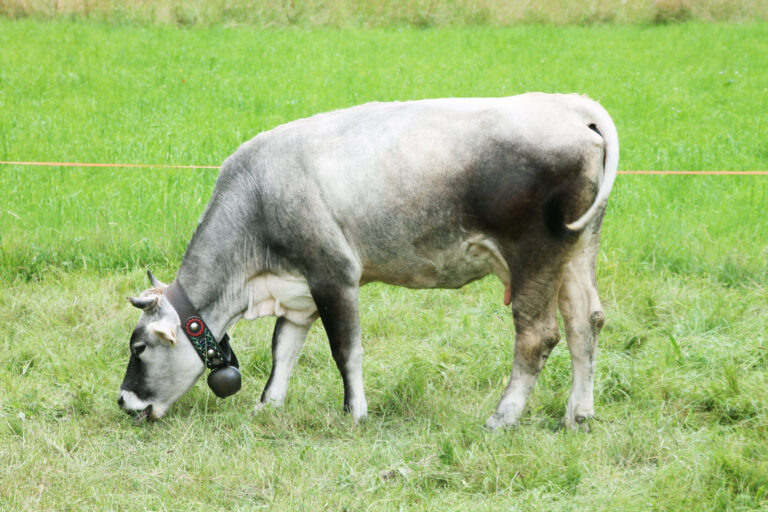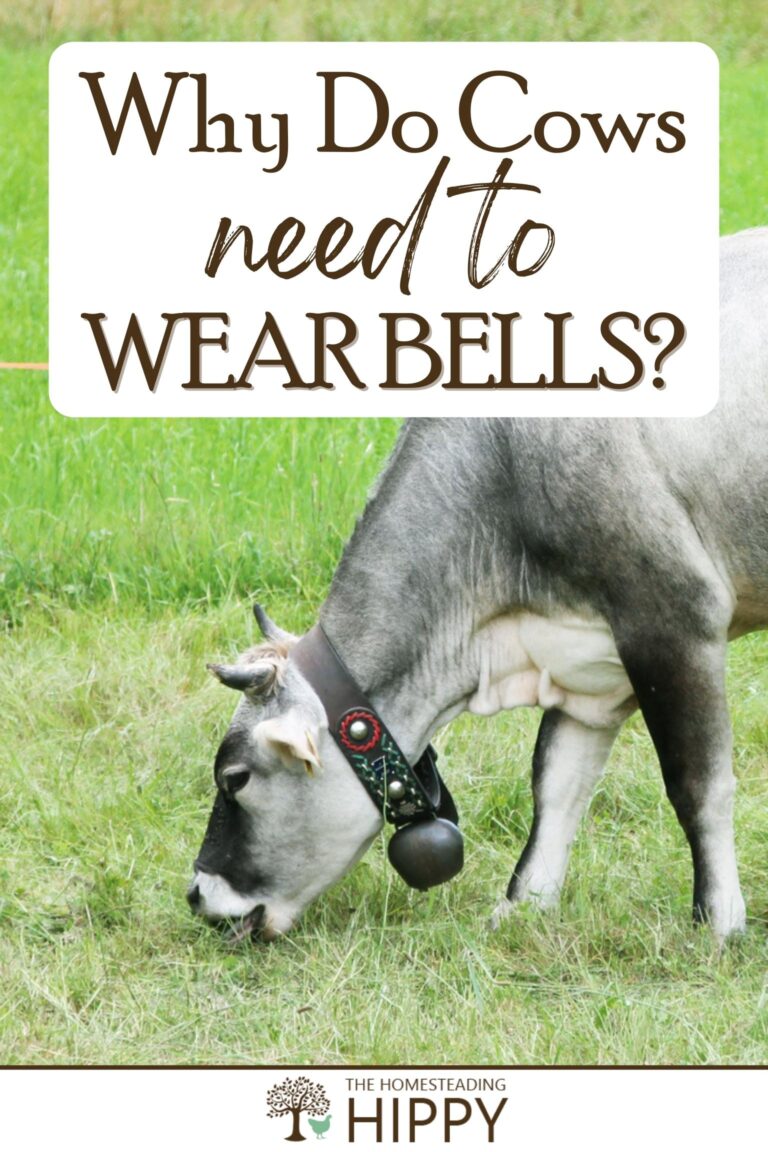If there is one image that is iconic to peaceful, rural life on a farm, it is that of a cow serenely walking around a pasture, with a cowbell gently tolling.

But do you ever wonder why cows wear bells in the first place? And the more you think about it the stranger it seems.
What’s the purpose? When did the practice start? Why do cows need to wear bells?
Cows wear bells so that farmers can remain aware of their location. Distant cows will be easier to locate since bells can be heard from a great distance. Bells also help ensure that a lost cow will be found.
Though it may seem a little strange, the practice of placing a bell around a cow’s neck is a practice stretching back hundreds of years, and there are good reasons for it.
In the rest of this article, we will discuss the purpose of cowbells, and what benefits they provide to farmers. Keep reading to learn more.
What Are the Benefits of Cow Bells for Farmers?
Cow bells are a common sight in many rural areas, and they play an important role in helping farmers keep track of their herds.
Cowbells, or more generically “livestock bells” have a distinct sound that is easily heard from a distance, making it easy for farmers to hear the location of a cow or herd as they move around the pasture.
Additionally, the clanking of bells signifies that a cow or herd is on the move, or active.
If a farmer cannot hear the bells at all, it tells him in an instant that the herd is at rest or too far away to be heard!
In this way, cowbells help cattle ranchers to more effectively manage their herds, keeping them safe and healthy while allowing them to graze freely on open pastureland.
Cowbells Help People Locate Cows Quickly in Emergencies
Cowbells are one of the simplest essential tools for farmers, providing a range of benefits that help them to be more productive, safe and efficient.
As mentioned, cowbells help farmers keep track of their animals during their day-to-day movements and routines, but they are also critical for locating cows quickly in emergency situations.
Bad weather, predators and other threats might see cows scatter, cross fences or generally become lost.
In this situation, cowbells will help searchers locate the cows with far greater reliability, especially in conditions of low visibility.
This is especially useful when trying to track down small groups or scattered individuals.
This reason is primarily why every, or at least most, cows in a herd get a bell instead of relying on only one or two to keep tabs on the herd as a whole.
Additionally, and of far greater importance for human safety, bells also help protect farmers and other pedestrians from being injured by approaching or charging cows.
In this case, bells serve as an early warning system for people working in close proximity to the animals, alerting them of the approach of a cow so that they can take needed action.
It seems a bit silly: how can you miss a cow? They are pretty huge!
But they don’t make much noise when walking around, and farmhands are often distracted by their chores.
Furthermore, cows, though often thought of as gentle or even lazy, may still act aggressively if they feel threatened, are hurt, startled or are protecting young.
The loud, rapid clanging of the bell when the cow is galloping can warn someone who is distracted and perhaps give them time to get out of the way or get to safety.
Consider that adult cows often weigh in excess of a thousand pounds, and can reach speeds of up to 25 miles per hour when running. Believe me; you don’t want to get hit by one!
What Materials Are Cowbells Made From?
Cowbells are made from a variety of different materials, depending on their size and function. Most commonly they are made from some kind of metal and hung from a cloth or leather collar.
Smaller cowbells might be made from thin sheets of brass, while larger cowbells might be crafted from bronze, sturdy steel or aluminum alloy.
Overall, the materials used in making cowbells help to determine not only their tone, but also their durability and resilience to all kinds of weather conditions and rough handling.
Are Cowbells Harmful to Cows?
The continued use of cowbells is a contentious topic.
The weight and bulk of a cowbell is thought to cause aggravation to the cows that wear them, and the tolling of larger bells can exceed 110 decibels in volume- that is louder than a jackhammer!
Understandably, people are worried about the well-being of the cows, and there have been reports that the bovines are initially quite disturbed by the presence of the bell.
Today, cowbells are still a common sight on farms, but there is some serious debate about whether or not they are harmful to cows.
Some argue that the constant jingling of the bell leads to pain, depression and certain hearing loss.
Others maintain that cowbells do not significantly affect cows’ stress levels and that the benefits of using them for safety and management outweigh any potential risks.
The results are somewhat inconclusive and ultimately, the decision of whether or not to use cowbells is up to individual farmers.
When Did the Practice of Putting Cow Bells Around Cows Necks Start?
The origins of the cowbell are shrouded in history, but there is some evidence of when the practice started.
In East Asia, suspected livestock bells made from pottery have been excavated and dated back to the 3rd millennium BC.
In the West, the earliest example of the cowbell has been traced to Britain between the 7th and 9th centuries AD.
It is probable that these bells were used for much the same practical reasons that we still use them today.
Cowbells have also played important cultural or spiritual roles in various cultures (and not just as a whimsical instrument for humans).
In some ancient cultures, the bell was thought to ward off evil spirits or people with evil intentions like cattle rustlers.
Even today, cowbells are still an important part of Swiss and other European cultures, and they can often be seen hanging around cows’ necks in mountain pastures.
In Swiss folklore, there is a tale of a young cowherd who ventures into a mountain and is offered by a beautiful fairy the choice of owning a treasure trove of gold coins, a huge golden cowbell, or the beautiful fairy herself. He opted for the cowbell!
Although the exact origins of the cowbell are a little murky, it is clear that it has been an important part of practical animal husbandry and folklore for many ages.
Cowbells Are an Iconic and Useful Tradition
Cowbells are an iconic and useful tradition that has been used by farmers for centuries to keep track of their animals.
The ringing of the bell alerts farmers to the location of their cows, making it easier to locate them or round them up at the end of the day.
Although there is some debate about whether or not cowbells are harmful to cows, most farmers adamantly believe that the benefits of using them outweigh any potential risks.
In short, it is clear that cow bells are an indispensable yet traditional tool for managing cows on a farm.

Tom has built and remodeled homes, generated his own electricity, grown his own food and more, all in quest of remaining as independent of society as possible. Now he shares his experiences and hard-earned lessons with readers around the country.
Find out more about the team here.

We are on Northern Minnesota. A friend of ours has Swiss bells on his cows. Not only do they help him locate them in his wooded pasture, but the bells also deter the wolves and coyotes.